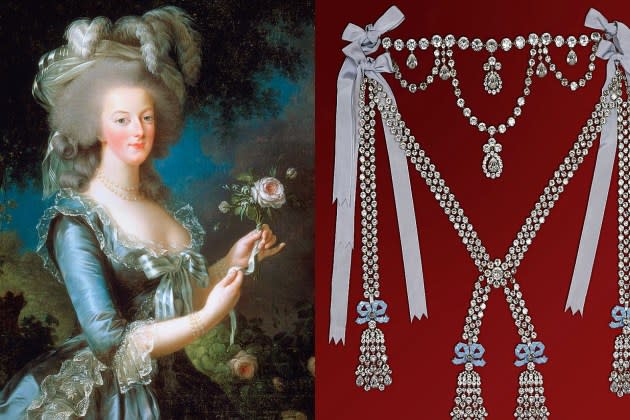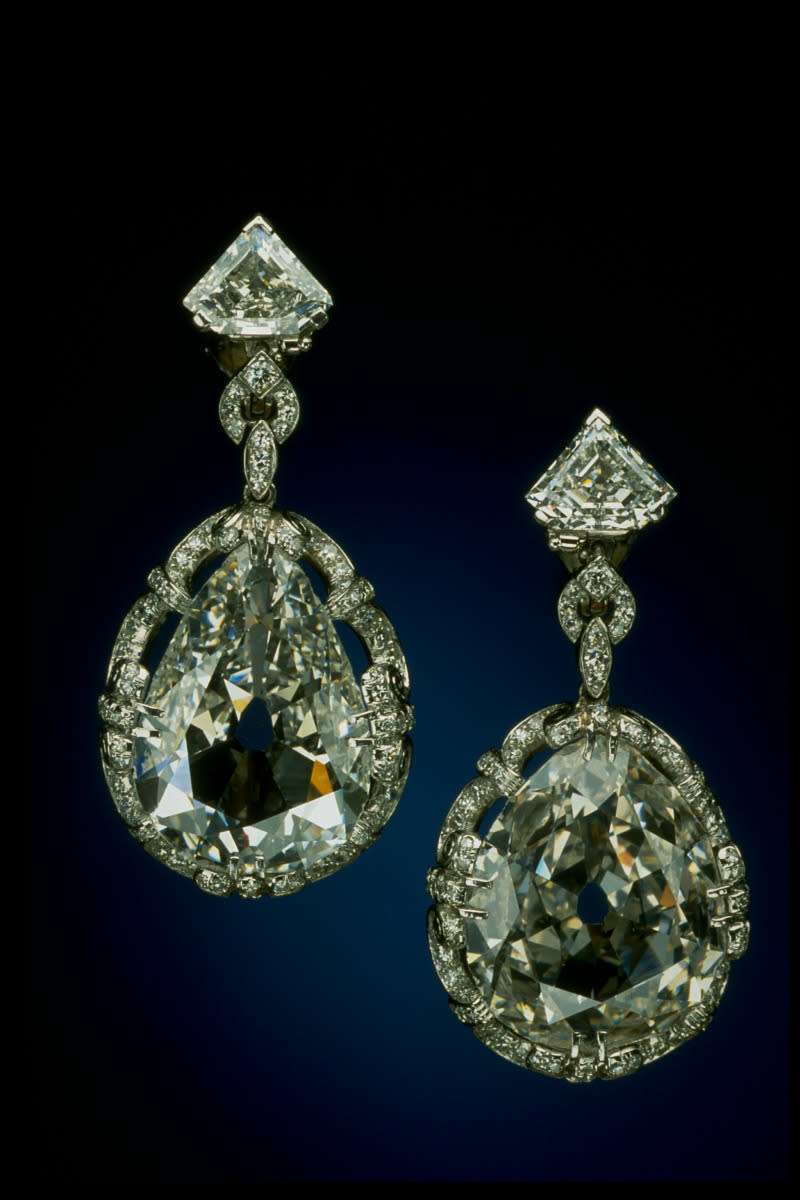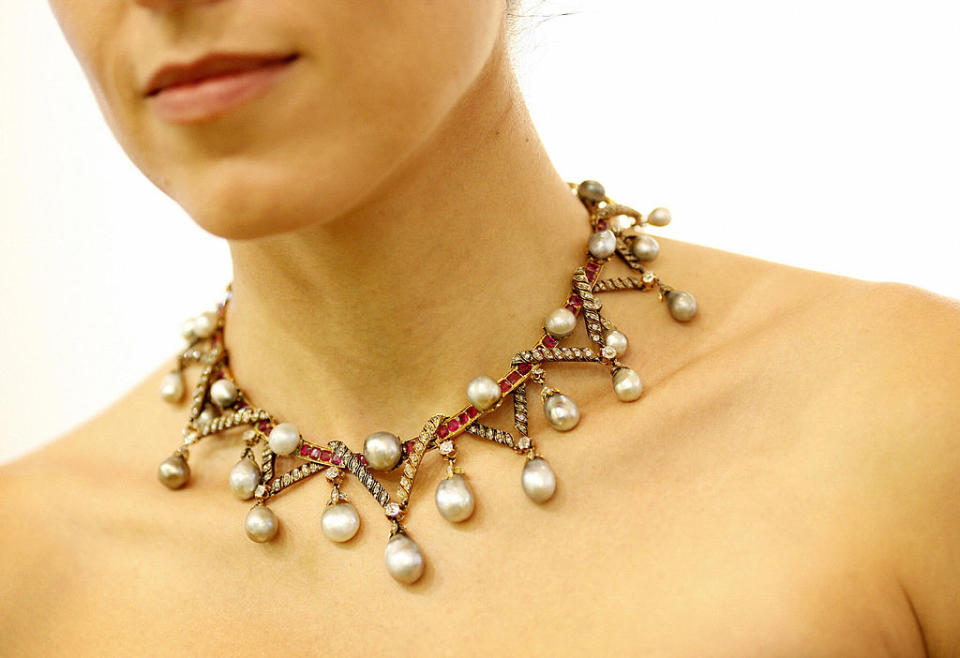What Happened to Marie Antoinette’s Jewels? Diamonds, Pearls and the Necklace That Launched a Revolution

Marie Antoinette was known — and eventually beheaded — for her lavish spending. The last Queen of France and her husband, King Louis XVI, met their untimely ends after squandering their vast fortune as their subjects starved.
The Queen’s annual clothing budget surpassed $3 million, according to journalist Laurence Benaim, author of “Fashion and Versailles.” Marie Antoinette’s expenditures naturally extended to accessories, including jewelry.
More from WWD
Ahead, see where the ill-fated royal’s precious gems ended up after the French Revolution.
The Affair of the Diamond Necklace

In 1772, King Louis XV commissioned a diamond necklace from Parisian jewelers Charles Auguste Boehmer and Paul Bassenge. Estimated to cost 2 million livres, the necklace was intended to be a gift to his mistress, Madame du Barry. The King died of smallpox before the piece could be completed.
The jewelers attempted to sell the necklace to Marie Antoinette, but she turned down the offer. Boehmer and Bassenge, in need of a buyer, got in contact with a noblewoman and con artist, Jeanne de Valois-Saint-Rémy, also known as Countess de la Motte. Posing as the Queen, she wrote several letters to a bishop and former ambassador, Cardinal de Rohan, convincing him to pay for the necklace on Marie Antoinette’s behalf.
Once the plot was discovered, la Motte and Rohan were arrested. La Motte ended up escaping from prison by disguising herself as a boy. Legend has it that the necklace was picked apart, with the diamonds being sold on the black markets of Paris and London.
While Marie Antoinette was found to have no involvement in purchasing the necklace, her already flawed reputation was permanently damaged by the diamond necklace affair. The ordeal is thought to be one of the major catalysts for the onset of the French Revolution.
The Bourbon-Parma Family Collection

Much of Marie Antoinette’s jewelry went missing during the French revolution. However, a number of pieces later resurfaced and were auctioned by Sotheby’s in 2018.
It is believed that Marie Antoinette’s jewelry was smuggled to Brussels and later to the Queen’s home country of Austria. After the French Revolution broke out in 1789, the King and Queen plotted an escape in 1791. Marie Antoinette packed her jewelry in a wooden chest and requested that one of her advisers transport it to Vienna, where they could be given to her nephew, the Austrian Emperor Joseph II, for safekeeping. The King and Queen’s getaway attempt failed, and they were quickly captured and ultimately executed.
Marie-Thérèse de France, the only surviving child of Louis XVI and Marie-Antoinette, received the jewels after she was exiled to Austria. She eventually bequeathed them to her niece, the Duchess of Parma. They were then passed down through the royal House of Bourbon-Parma.

Among the pieces in the Bourbon-Parma collection included a three-strand pearl necklace with a diamond clasp, a bow brooch adorned with a yellow diamond, and a diamond ring baring the Queen’s initials, which also contained a lock of her hair. One of Marie Antoinette’s natural pearl and diamond pendants fetched a record-breaking $36 million at auction, a world record for a pearl.
In total, the suite realized $42.7 million, with the aforementioned pearl necklace achieving $2.2 million.
Marie Antoinette’s Diamond Earrings

Two diamonds that belonged to Marie Antoinette currently sit in the Smithsonian’s collection. The pear-shaped stones, clocking in at 14 and 20 carats, respectively, were sourced in either India or Brazil. It is believed that they were set in earrings belonging to the Queen, though Napoleon III later gifted them to his wife, Empress Eugenie, upon their wedding in 1853.
After Napoleon III was overthrown, the French Crown Jewels were sold in 1887. Eugenie, exiled to England, sold her personal jewels between 1870 and 1972. At that point, they were acquired by the Russian royal family. Jeweler Pierre Cartier purchased the diamond earrings from them in 1928 before selling them to American businesswoman Marjorie Merriweather Post.
By 1959, Post had Harry Winston mount the jewels onto new diamond and platinum settings. In 1964, Post’s daughter, Eleanor Barzin, donated the earrings with their original settings to the Smithsonian. Today, they’re exhibited in the Gem Gallery at the National Museum of Natural History.
Marie Antoinette’s Gray Pearls

Twenty-one gray pearls that once belonged to Marie Antoinette were put up for auction by Christie’s in 2007. Set in a diamond and ruby necklace from 1849, the pearls are dated to more than half a century earlier. The pearls were originally paid for in cash and gems, with Marie Antoinette giving them to her good friend, Lady Sutherland, Elizabeth Leveson-Gower, wife of the British ambassador Lord George Leveson-Gower, to guard upon her family’s attempted escape in 1791.
Marie Antoinette’s Diamond Bracelets

In 2021, two more pieces of Marie Antoinette’s jewelry were put on the block by Christie’s. Belonging to the Bourbon-Parma family for more than 200 years, these two diamond bracelets were made by the Queen’s personal jeweler, Charles Auguste Boehmer.
Made with 112 diamonds ranging from one to 4.5 carats and set in both silver and gold, Marie Antoinette purchased the bracelets for 250,000 livres — equivalent to around $4.6 million today.
At auction, the pieces were sold for $8.2 million.
Who Owns Marie Antoinette’s Jewelry Now? See What It Looks Like Today [PHOTOS]



Launch Gallery: Who Owns Marie Antoinette's Jewelry Now? See What It Looks Like Today [PHOTOS]
Best of WWD


